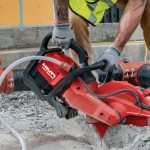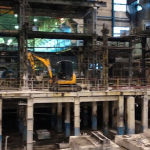If you work in construction, you’ve no doubt heard of core drilling or concrete core drilling. You may even work in core drilling Industries yourself. Core drilling is a revolutionary new way to cut accurate circular holes in rigid materials, such as concrete, and it has become something that almost every building project utilises in some way or another.
What is core drilling? What industries benefit from core drilling? And what problems does core drilling solve? This blog will answer all your questions about concrete core drilling, and by the end of this blog, you will have a better understanding of this fundamental core (pardon the pun) drilling service.
What is core drilling?
Core drilling is the process of cutting a perfectly round hole into reinforced or non-reinforced concrete. This is achieved using a hollow and cylindrical cutting bit fitted with diamond teeth. This cylindrical drill bit is mounted to a powerful and efficient non-vibratory drilling machine and is then mounted to the floor, wall or ceiling to cut a hole to a specific size. Holes can be as small as 10mm all the way up to 1.8 metres (for highly skilled operators).
Rather than obliterate and grind up the substrate, the hollowness of a core drilling bit allows for a solid core (hence the name) of material to be cut and removed from the main work surface. This unique feature of core drilling reduces mess and means less of that nasty concrete dust gets into the air.
Compared to hammer drills and other vibratory drilling methods, core drilling is a more quiet process. This means it is the perfect tool to use when you need a hole cut into or through something but excessive noise could be an issue, such as hospitals, focused workspaces or schools.
If you need an accurately circular hole cut into a concrete or brick wall, floor or ceiling, then Concrete Core Drilling is for you!
What industries benefit from core drilling?
Now that you know what Core Drilling is, it’s going to be useful to know where you can use it!
Core drilling can be used across many industries in a variety of ways. Some of its more common applications come from Electricians. An electrician will often need to make way for conduit and cabling through rigid substrates such as concrete or solid blockwork.
Plumbers are another big user of this technique. Qualified plumbers will often find themselves calling for a core driller when they need to get some new pipe into an old building or when they find a client that decides they want to change up the layout of their bathroom.
Core drilling is an excellent technique for all different types of construction. For example, creating holes for starter bars, hold down bolts, home extensions, manholes, HVAC and commercial fits outs. If you need a clean hole cut cleanly and efficiently, you can’t go past core drilling.
What problems does core drilling solve?
- Drilling holes in concrete or stone is a messy business when using standard crushing or pulverising hammer drills. A core drilling machine uses a hollow cylinder to cut a solid core of material away from the work surface rather than turning that mass into a fine slurry or dust. If you want to save time, energy and money by not having to clean up a mess, core drilling might be the perfect solution.
- The traditional way to cut holes into surfaces that are harder than wood is to hammer away at the material until the hole forms. This is a very noisy process, and depending on the location of the project at hand is not an ideal outcome. This is one of the areas where core drilling really shines. Core drilling is a far more ‘ear friendly’ method for hole cutting and, as such, is the best choice when working in or near a hospital, care facility, school or university.
- Cutting a perfect hole of any size into a solid concrete surface is no easy feat, but core drilling makes this task easier and quicker. Depending on the skill of the operator on the machine, you will be able to cut a hole over a meter in diameter.
- Need a hole cut, but not a round one? Stitch Drilling or Line Drilling is a method of drilling a series of consecutive holes that overlap each other slightly so that you can remove large chunks of material. This can be useful for those jobs where a concrete saw just doesn’t fit the bill.
- Need a challenging hole cut in the ceiling? No problem! Inverted drilling is a type of core drilling that is used when a hole needs to be cut through the underside of a concrete structure when access from above is restricted.
Inverted core drilling applications can include ceilings, walls, bridges, tunnels and road surfaces, as well as coring cylindrical holes to allow for cables, plumbing piping, electrical wiring and HVAC systems.
Need accurate, high-quality and efficient core drilling?
Concrete core drilling is the perfect way to cut holes and remove materials in solid substances like concrete, masonry, stone and brick. It’s a quiet way to get the job done, and it keeps the workspace clean whilst reducing toxic particulates in the air.
Pristine Technical Services is a trusted concrete drilling company in Perth for more than 36 years of experience providing high-quality and efficient core drilling services. We continually invest in the latest core drilling equipment and safety training and are committed to delivering a high-quality finish on time.
For perfectly round holes, in all different sizes, in all sorts of challenging materials, contact Pristine Technical Services today.



